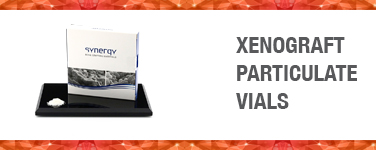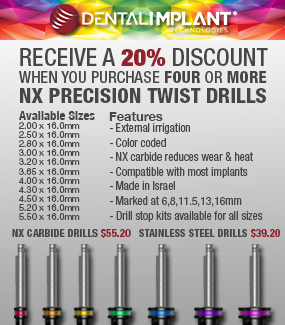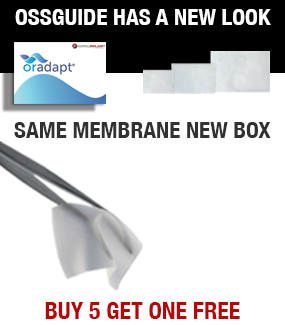Xenograft
Order Animal Bone Graft Materials Online
Dental Implant Technologies® is a one-stop online distribution center for reliable dental products from the world’s most trusted brands. Delivering a convenient and secure shopping model with a range of products for implantation and regenerative procedures, it’s simple to find the necessary supplies to carry out a range of surgeries in the United States.
Bone grafting is a complex area of dental surgery, requiring immense skill and reliable materials. Synthetic bone grafting materials have increased in popularity in recent years, especially as costs have stabilized. However, for many surgical applications, animal bone grafting materials are still preferred, and the competitive cost and unique properties make them ideal for many patients and surgeons.
Explore our range of Synergy Xenograft bone graft and MatrixOss™ particulate materials and order online in total confidence.
Animal Bone Graft vs. Synthetic Grafting Materials
Bone grafting is a complex biomechanical procedure that can be facilitated with both synthetic and naturally-derived grafting materials. Dental professionals have a vast array of options on the market today, although natural particulates are often more affordable. While loose particulates require more preparation and a more complex application than most synthetic grafting materials, the functional results are often identical.
Xenograft bone graft is a term signifying that donor tissues are derived from a species different from the host. In the case of dental procedures, a xenograft refers to animal-derived bone grafting.
- Animal bone graft materials are derived from porcine (pig) and bovine (cow) sources.
- Synthetic grafting materials are sometimes composites, using man-made materials like ceramics (including calcium phosphate) as well as those harvested from animals.
Collagen is a key component of any successful synthetic grafting procedure. The collagen derived from animal bones contains proteins that stimulate the growth of new bone tissue. If calcium is combined in the material, it creates a three-dimensional structure to assist in bone growth.
Animal bone grafting particulates are highly biocompatible and pose no risk of rejection or complication in terms of bone growth. However, incorrect surgical procedures and poor patient care can still result in complications like infection or graft exposure. Regardless of whether synthetic or natural grafting materials are used, it’s essential that surgeons follow all established procedures while providing the patient with comprehensive aftercare instructions and follow-up consultation.
Animal-derived bone grafting materials can provide an efficient base for bone regeneration for reconstruction, cosmetic improvements, dental implantation, and a range of other procedures.
Surgical Application of Animal Bone Graft Particulates
Grafting particulates can be used for any procedure where there is insufficient density, or damage to the jawbone. Particulates may also be used for some sinus procedures.
The main causes of bone loss for patients are:
- Highly advanced and untreated periodontal disease.
- A damaged or worn-down alveolar ridge (sometimes caused by poorly fitted dentures).
- Developmental defects in the oral bone structure.
- Missing teeth that have led to bone deterioration.
- Aging.
Surgeons that identify significant bone loss can choose to use animal bone graft products to facilitate regeneration and allow the possibility of restorative procedures like implantation.
Bone grafts are typically necessary when:
- A patient has undergone an extraction procedure and there is a risk of bone being reabsorbed into the body.
- Tooth loss has led to bone deterioration that has changed the facial structure.
- Patients have severe gum disease. Grafting may help to retain loose teeth that remain viable.
- A patient requires dental implantation but lacks the bone density to support the implants.
Our animal bone graft products can be used by dental professionals to prepare patients for surgeries that improve health and self-confidence with a natural smile.
Synergy Xenograft Bone Graft Materials
Synergy animal bone graft materials are available in small and large particle packages, offering surgeons a choice for use in both minor and major bone regeneration procedures.
Synergy is a biocompatible bone mineral derived from bovine natural materials. Organic components are removed from the harvested bovine bone. Synergy is a porous compound when analyzed at a microscopic level. The pores ensure that there is a stable supporting structure to allow for the generation of new bone tissue. All Synergy xenograft bone graft materials are FDA approved.
Typical applications for Synergy include augmentation or reconstruction of the alveolar ridges, filling defects, filling extraction sockets, elevating the maxillary sinus floor, and filling defects caused by previous implantation procedures.
Synergy acts faster than Bio-Oss™, a competing grafting material. Particles are absorbed at a slower rate when compared to Bio-Oss™, ensuring that bone regeneration is well-supported to meet surgical goals.
Synergy animal bone graft materials can be ordered in sterile vials for single use. Browse our complete range of small and large particle packages to stock your surgical inventory.
MatrixOss™ Porcine Particulate Animal Bone Graft Materials
We also offer MatrixOss™ porcine particulate materials. These products are derived from harvested bones of domesticated pigs, with organic materials removed in the processing stage.
MatrixOss™ guarantees a thorough processing stage to eliminate and inactivate viruses that may be present. The granules are packaged sterile and are 100% biocompatible. Each vial is for single use only.
The carbonate apatite structure of MatrixOss™ is designed to be highly osteoconductive. This helps to support new bone tissue growth, minimizing downtime between grafting and the need for follow-up procedures. The resorption profile of this animal bone graft material is similar to that of natural human bone, outperforming synthetic materials like hydroxyapatite and calcium phosphate.
Six packages are available with particle sizes ranging from 0.25mm to 2.0mm. Volumes range from 0.5cc to 4.0cc to ensure efficient use of the single-patient vials.
Browse our complete range of MatrixOss™ Porcine Particulate grafting materials to find the perfect addition to your inventory.
How Safe are Xenograft Bone Graft Materials?
In healthcare, xenograft bone graft materials are considered exceptionally safe and are used for a variety of purposes including dental bone grafting and other types of bone grafting. There are specific procedures followed to remove organic components and sterilize the materials. These procedures can vary from manufacturer to manufacturer, but the basic elements are consistent.
- Source material selection is one of the most important aspects of developing xenograft bone grafts. Bovine (cow) and Porcine (pig) are the two sources used for dental xenograft bone grafts. These animals are typically raised for food production and are subjected to regular veterinary inspections to ensure health.
- Tissue collection from the animal source is performed in compliance with strict regulations and industry standards. The bone used is typically cortical.
- Bones are cleaned and decontaminated to remove remaining soft tissue.
- Decellularization is performed to produce xenograft bone graft. This involves removing the cellular components from tissue. There are physical, chemical, and enzymatic steps used to remove cellular components. This is performed to remove immunogenic components while keeping the underlying structure of the bone, so it is suitable for regeneration.
- Demineralization can be performed to remove hydroxyapatite from the bone structure, which enhances osteoconductivity, the process which supports remodeling and new bone formation.
- All materials are sterilized before packaging. Gamma irradiation in low doses is the most common sterilization method although some manufacturers use gas sterilization or electron beam sterilization. This is an essential final step that removes pathogens without compromising the grafting material.
Immunological response to xenograft bone grafting materials is minimal, outside of the typical healing properties of the body. Patients can be confident that xenograft materials are harvested ethically, and in compliance with regulations, and that the processing methods are extensive to ensure a safe and effective product to be used in dental procedures.
Order Animal Bone Graft Materials from a Leading American Supplier
We’re ready to take your order of xenograft bone graft materials today. Naturally-derived grafting products can improve regenerative response with full biocompatibility and minimal risk of infection. We maintain stock of all our particulate vials to ensure that dental professionals can enjoy rapid delivery for inventory maintenance and upcoming surgeries.
Order online from our secure online store for competitive prices and industry-leading customer service. Browse and order now, or contact us today for sales and order support.






